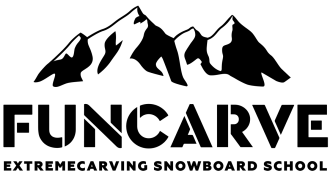Carving technique. Up-unweighting
This is the way to change edges which is great for downhill, riding slalom runs and challenging slopes. It is characterized by stability at high speeds and reliability at steep slopes.
Up-unweighting is widely used in sport slalom competitions. Apart from high stability it has greater maneuverability than, say, down-unweighting. The fact is that when a snowboarder unbends their knees quickly their weight can be fully removed from the edge and the snowboarder can direct their board on the snow along the necessary trajectory and at the right angle.
Unfortunately in sport conditions snowboarding loses its beauty. Hasty and hursh movements, waving arms and angulation at maximum affect negatively the aesthetics of the carving. An amateur rarely faces situations when up-unweighting is really necessary because usually they ride wide and free slopes where there is enough space for the turn.
To make a beginner understand what vertical work is, in most cases instructors choose up-unweighting believing that it is easier to understand and to learn than down-unweighting. In reality these techniques are equally difficult and it is the trainee who should choose the technique to learn. If they need sport technique with maximum stability and maneuverability then they should choose up-unweighting and accept its strange aesthetics as it is. If they need beauty and harmony at the sufficient level of stability then it is better to start with down-unweighting.
The phase of turn
Right after edge change your knees are straightened, your weight is distributed evenly between your legs. Next you need to bend your knees progressively until you reach the desired moment of edge change. Remember that any vertical motion should be performed during the whole phase of turn!
Change of edge
For transferring from one edge to another you need to unbend your knees harshly and direct your body up and inside the next turn thereby removing your weight from the edge. In the very beginning of next turn your weight should be 50:50 again, your legs should be almost straightened and you should be in basic position.
Typical mistakes
- Deviations from the basic position.
The technique is difficult itself because of human anatomy. When bending knees on backside people often turn their bodies into ‘minus’ which leads to underloading of the nose of the board and to broken carve. You should control your hips position and correct it by turning the knee of your back leg.
- Incorrect weight distribution.
In fact when you straighten your legs you like jump up with your board. When ‘landing’ you can overload one of the legs so when learning try to straighten your knees more smoothly thinking about the following edging. - Too early bending of the knees in the phase of the turn.
Remember that you need to bend your knees smoothly while the whole phase of turn! Of course this doesn’t mean that you need to do it slowly. You need to determine the distance to the next edge change and you should choose how quickly you need to bend your knees depending on this distance; - Substitution of vertical motion in knees by bent back and waving hands.
You need to understand that it is more comfortable and efficient to use your lowest loose joint – your knee. And your body should be straight and stiff so that it would transfer the weight to the edge properly.



